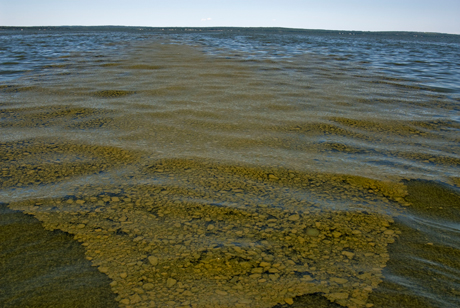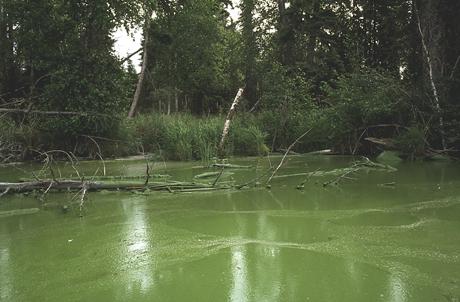What is blue-green algae?
Algae are a group of very small (microscopic) organisms which often live in water.

Source: Ron Zurawell, Alberta Environment
Blue-green algae (also called cyanobacteria) are a type of bacteria found in many lakes, ponds, and reservoirs. These bacteria can multiply a lot in the summer, which causes extensive growths called blooms. Algae often form when conditions are calm, and they look like scum on the surface of water. The algae can be blue-green or greenish-brown and often smell musty or grassy.

Source: Ron Zurawell, Alberta Environment
Some bloom-forming types of blue-green algae produce toxins. When toxic blooms die and decay, toxic chemicals may be released into the water. Most toxins are degraded within 2 weeks, but can be in the water at low levels for many months after a bloom forms. Some blooms are so bad that they cause livestock deaths. Some blooms don’t contain toxins, but you can’t tell if a bloom is harmful or not from how it looks. If you see a bloom, always take precautions as if it is toxic.
How does blue-green algae affect human health?
Children might be more at risk for getting sick from blue-green algae because they often spend more time in the water and may swallow contaminated water by accident.
If you have
contact (e.g., swimming, boating) with water containing blue green algae, it can cause:
- skin irritation and rash
- sore throat
- sore, red eyes
- swelling of the lips
- hay fever symptoms (e.g., stuffy nose)
If you
drink water with blue-green algae, it can cause:
- headache
- diarrhea
- weakness
- liver damage
- fever (temperature over 38.5 °C or 101.3 °F)
- nausea and vomiting
- muscle and joint pain
- cramps in the abdomen
Treat all algae blooms with caution. Call Health Link at 811 if you have been in contact with water that has blue-green algae and are having symptoms.
How does blue-green algae affect livestock and pets?
Although lakes are often a good source of drinking water for livestock and pets, lakes contaminated with blue-green algae can be deadly if algae toxins are present. Some illnesses and deaths of livestock and wildlife have been linked to animals drinking water containing blue-green algae. Keep animals away from natural water sources that contain algal blooms because animals aren’t concerned about how water looks or smells before they drink it. Don’t let animals eat whole fish or trimmings (any waste from filleting a fish including the head, bones, intestines, or skin) from affected lakes.
What about watering my vegetable garden?
Don’t use water with blue-green algae to water edible plants (especially plants with edible parts exposed to the ground surface like cabbage, lettuce, tomatoes, and other salad vegetables). It's not known if fruits and vegetables absorb toxins from algae-contaminated water.
Is it safe to cook with water that might contain blue-green algae?
Boiling water doesn’t remove blue-green algae toxins. Don’t cook with water that might contain blue green algae.
Is it safe to eat fish from water that might contain blue-green algae?
You can safely eat fish fillets from lakes affected by blue-green algae. You might want to limit how much whole fish and trimmings (any waste from filleting a fish including head, bones, intestines, or skin) you eat, because it is known that fish store toxins in their livers.
Testing is being done on the livers of fish from Alberta lakes. These test results may inform future updates to the fish consumption advisory messages.
How can I prevent algae growth?
- The best way to help prevent algae growth is good watershed management.
- The best way to control algae in natural waters is to limit nutrients that go in the water body (e.g., waste water effluent, agriculture runoff). You can limit nutrients by not using lawn fertilizers and by properly maintaining your private sewage systems.
What else do I need to think about?
- Treat any algae bloom as if it is contaminated.
- Don’t swim or wade in water with scum on the surface.
- Don’t drink water if it might be contaminated with algae.
- Have another source of drinking water for pets and livestock.
- If you see a bloom, call Environmental Public Health.
- Call Health Link at 811 if you have been in contact with contaminated water and have any of the symptoms listed above.
- Call a vet if your pet has been in contact with contaminated water.
If you have any questions, contact
Environmental Public Health.
